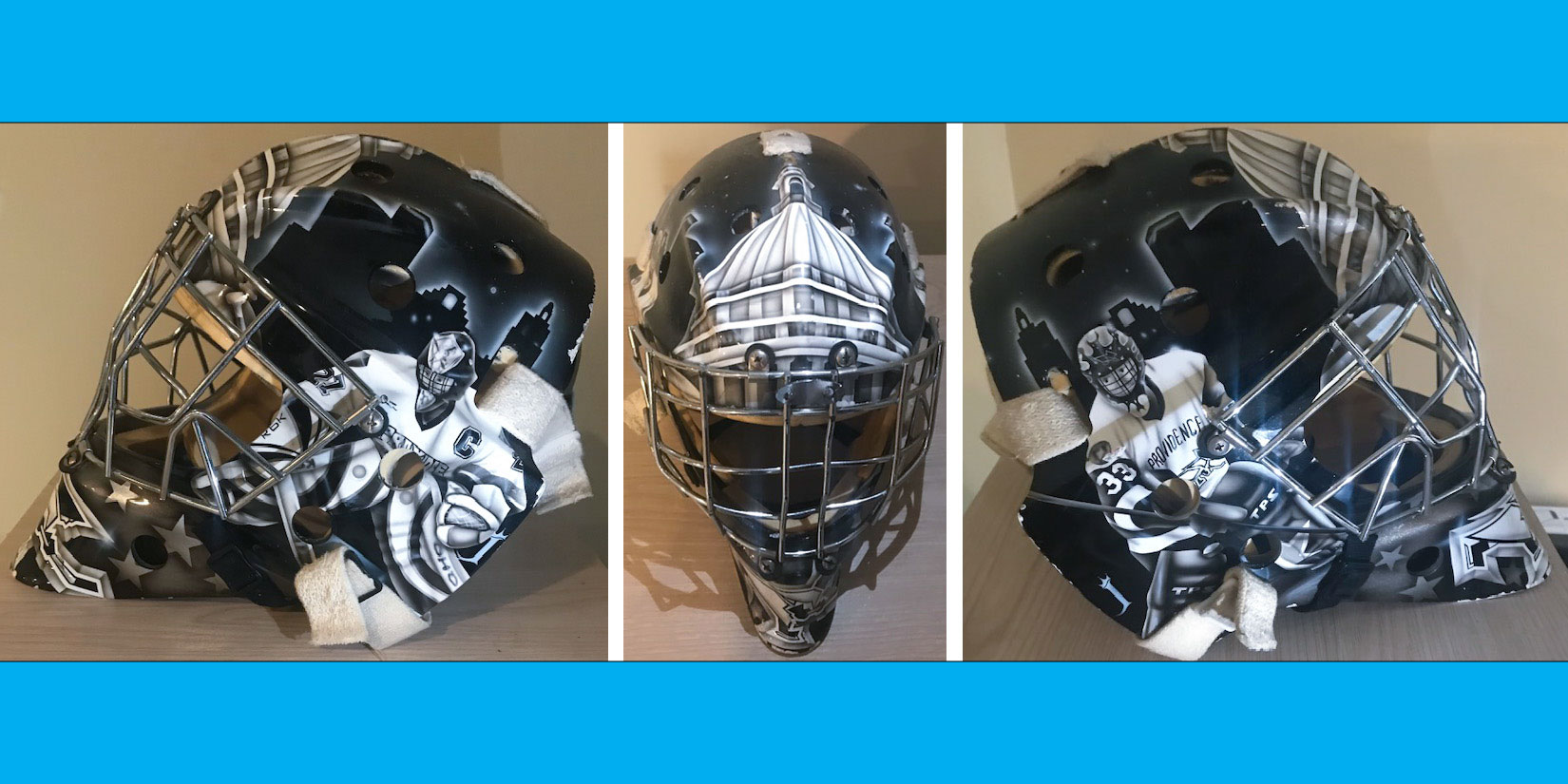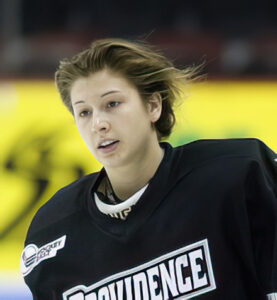 When sculpting her collegiate credentials as a student-goaltender, Genevieve Lacasse did not quite roam the earth, but did cover two countries and two-thirds of the NHL’s Original Six regions. Native to Montreal, she saw action for scholastic or travel teams around Toronto, Chicago, and Detroit.
When sculpting her collegiate credentials as a student-goaltender, Genevieve Lacasse did not quite roam the earth, but did cover two countries and two-thirds of the NHL’s Original Six regions. Native to Montreal, she saw action for scholastic or travel teams around Toronto, Chicago, and Detroit.
Her attachment to her home and native land never tapered. But when it came time for higher-ed hockey, Lacasse signaled the title of the local state anthem, “Rhode Island’s It For Me,” by choosing Providence College ahead of the fall of 2008.
Even a month before orientation, and two before her first game, she had a plan to tell that to the world. But first she phoned PC head coach Bob Deraney to explain how.
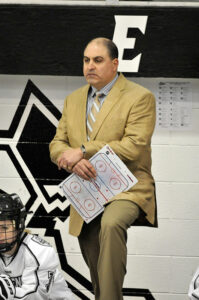 “‘I have some ideas for my mask’,” Deraney, himself a former netminder, remembers her saying. “‘I wanted to know what you thought.’”
“‘I have some ideas for my mask’,” Deraney, himself a former netminder, remembers her saying. “‘I wanted to know what you thought.’”
Lacasse elaborated that she wanted the likenesses of the program’s two all-time most ornate goalies — Sara DeCosta and Jana Bugden — then asked their former coach what he thought they would make of it.
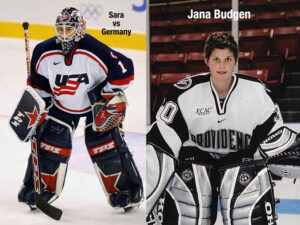 “They would be honored,” replied Deraney, whose first of 19 seasons (1999-2018) at Providence was DeCosta’s last and who oversaw Bugden’s whole college career.
“They would be honored,” replied Deraney, whose first of 19 seasons (1999-2018) at Providence was DeCosta’s last and who oversaw Bugden’s whole college career.
“And that just speaks to the type of person Genevieve was,” he said by phone in October, after Lacasse confirmed her retirement from a 15-year thrill ride in the intercollegiate, international, and professional ranks. “She always had respect for the tradition of Providence College women’s hockey, and she knew the expectations she had coming in.”
If only for her first homestand as a Friar, Lacasse let her long-term goals be known to every spectator at Schneider Arena. Her mask bore a bright red backdrop with an unmistakable maple leaf and forward-facing skating silhouette hogging the foreground.
The Providence-themed lid was not ready yet, nor would it be until its user decided it was. Deraney recounted untold “renditions that were sent back and forth before she confirmed it was what she wanted and the way she wanted it.”
That same fastidiousness was palpable in practice. RIHHOF honoree and then-PC goaltending coach Bob Bellemore openly marveled at Lacasse’s untamed work ethic.
To explain herself, Lacasse simply cited the generous scholarship she had garnered.
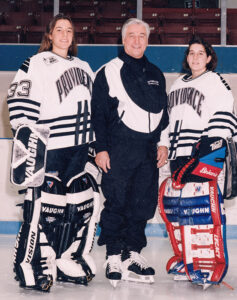 “From the moment she stepped on campus you could see her respect and admiration for her historic hockey program, embodying a true passion for its legacy and the values it represents,” said her former teammate and classmate Christie Jensen.
“From the moment she stepped on campus you could see her respect and admiration for her historic hockey program, embodying a true passion for its legacy and the values it represents,” said her former teammate and classmate Christie Jensen.
This was a program that, in its first 34 seasons, had won 10 conference titles (seven ECAC, three Hockey East); produced seven U.S. Olympic gold medalists (including RIHHOF inductees DeCosta and Cammi Granato); was about to send another alum to the 2010 Vancouver Games; and had a Torino 2006 veteran from Finland on its active roster.
 But with senior Danielle Ciarletta and sophomores Christina England and Jen Smith, that roster also had three incumbent goaltenders. And for all of Lacasse’s promise on paper, Deraney’s word of the month was “meritocracy.” Performance in the here and now and nothing else would dictate the depth chart.
But with senior Danielle Ciarletta and sophomores Christina England and Jen Smith, that roster also had three incumbent goaltenders. And for all of Lacasse’s promise on paper, Deraney’s word of the month was “meritocracy.” Performance in the here and now and nothing else would dictate the depth chart.
For the 2008-09 Friars’ sole preseason scrimmage, three goaltenders played one period apiece. Lacasse took the third. To begin her intercollegiate slate, she claimed the second string behind Ciarletta, but regularly rotated in as early as Game 2 amid a seesaw start to the squad’s record. By the quarter mark, she had played in five out of nine contests.
As the campaign took shape deeper into her first New England autumn, the foliage on her face gave way to a more blizzardly look, a monochrome white helmet. But the clarity of spring soon sprouted on the facade, fittingly reflecting Lacasse’s point-of-no-return ascent to the uncontested starting job.
The final rendition of the heavy-by-design crown she envisioned in August bore tributes to the program plus the namesake city. The Rhode Island State House — visible from the southeast end of campus and barely a 15-minute ride away on RIPTA’s No. 55 bus — claimed the forefront. Combined with a smooth nighttime sky, it made a black-and-white pattern sync with the Friars home and road threads alike.
Standing before the skyline on the sides, and implicitly helping her tune out any potential outside disturbances, were those action portraits of DeCosta and Bugden.
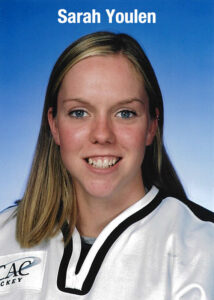 While the guardian mystics kept distractions out of Lacasse’s ears, the program’s adopted mantra from another once-and-always constituent filled her brain from behind. Like the wall of the team locker room, the back plate of Lacasse’s helmet quoted 2004 graduate Sarah Youlen: “Those who have come before us have done excellently, our goal is to surpass them all.”
While the guardian mystics kept distractions out of Lacasse’s ears, the program’s adopted mantra from another once-and-always constituent filled her brain from behind. Like the wall of the team locker room, the back plate of Lacasse’s helmet quoted 2004 graduate Sarah Youlen: “Those who have come before us have done excellently, our goal is to surpass them all.”
“Genevieve was clearly a special person and player from the moment she stepped on campus,” said Erin Normore, who played with Lacasse in 2008-09, then coached her as a graduate assistant the next two seasons. “She understands and appreciates the history and who paved the way. She didn’t just want to be a part of the team, but a part of the program.”
At times, Lacasse appeared keen on exceeding everyone else’s looks at the ice and then lapping herself. Already in a position to log the most minutes on the game clock, she frequently spent intermissions at the door to the rink down the runway behind the cage she tended for the first and third periods.
For those shifts, the mask was one of the select few parts of her getting a proper, private reprieve in the dressing room. In its stead, a set of headphones spelled Budgen, DeCosta, and Youlen in pumping motivational messages into her mind and tuning everything else out.
If that arrangement was geared toward stability, it delivered. In her Autumn of Three Masks, Lacasse aggregated an 8-4-0 record in 12 appearances out of a possible 17 at the regular season’s halfway mark. By the end of her freshman campaign, playoffs included, she had started 28 out of 36 games and lent relief in another, consuming more than three-quarters of the cumulative crease time and going 15-11-1 with six shutouts.
 Ahead of her bid for an encore, she joined her lid as a full-page model in PC’s 2009-10 women’s hockey media guide. The spread featured a side profile of the netminder on duty plus close-ups of the Bugden rendering, DeCosta drawing, and Youlen quote.
Ahead of her bid for an encore, she joined her lid as a full-page model in PC’s 2009-10 women’s hockey media guide. The spread featured a side profile of the netminder on duty plus close-ups of the Bugden rendering, DeCosta drawing, and Youlen quote.
Concomitant with that yearbook pictorial, Schneider Arena introduced life-size action shots of all three goalies in a collage of legendary alumnae. Between the women’s mural on one bookend of the lobby and the men’s on the other, Lacasse was the only active player portrayed.
“She epitomized excellence,” said Deraney. “Just like what our program was meant to stand for, and she personified it.”
To continue that propensity with a sophomore encore, Lacasse played every non-empty net minute except the final 4:48 of one game in 2009-10. Her share of the crease time that year came to precisely 99%. The only reason she didn’t match that in 2010-11 was because she missed three contests in early January to represent Canada at the 22-and-under MLP Cup tournament.
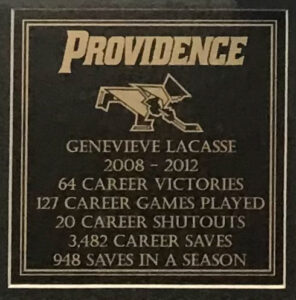 As it happened, she made her mask over once more after a career year in all other categories as a junior, and right after eclipsing Bugden on PC’s all-time save leaderboard at 2,556. She reached that summit amid the 2011 Hockey East semifinals where, with 58 stops, she also revised the league tournament’s single-game save record set literally three hours prior by Northeastern sensation Florence Schelling.
As it happened, she made her mask over once more after a career year in all other categories as a junior, and right after eclipsing Bugden on PC’s all-time save leaderboard at 2,556. She reached that summit amid the 2011 Hockey East semifinals where, with 58 stops, she also revised the league tournament’s single-game save record set literally three hours prior by Northeastern sensation Florence Schelling.
When she reemerged for her senior season, her helmet bore a silver backdrop behind team-specific lettering and heraldry. The State House gave way to the familiar Skating Friar, who was now the only human in the artwork.
But while the civic symbols and her predecessors in the crease were not re-upped, the drive was. Its infectiousness manifested when, in due time, determination overshadowed disappointment in the wake of her last crack at a Hockey East crown.
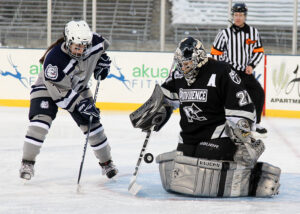 After shutting out Maine in the first round and then outdueling Schelling’s first-place NU Huskies in the semifinals, 2-0, Lacasse came to within seven seconds of blanking Boston University for the championship. Then world-class striker Jenn Wakefield gave the Terriers an eleventh-hour equalizer, followed by the title at 2:15 of double-overtime.
After shutting out Maine in the first round and then outdueling Schelling’s first-place NU Huskies in the semifinals, 2-0, Lacasse came to within seven seconds of blanking Boston University for the championship. Then world-class striker Jenn Wakefield gave the Terriers an eleventh-hour equalizer, followed by the title at 2:15 of double-overtime.
But a decade-plus later, the brighter side of PC’s effort, which explicitly started from the crease outward, radiates.
“Even a lesser team would have lost in the first overtime,” Deraney reflected. “The amount of pride that that team had permeated, not just from Genevieve, but all the way up and down the lineup. The sum of our parts was even greater than our individual parts.”
Come what may, the sum of Lacasse’s individual achievements and accolades was impossible to miss. She held a co-captaincy for the 2011-12 season, which culminated in a repeat all-athletic-department female player of the year award and the real-life DeCosta presenting her third straight team MVP honor.
She had soared to the top of PC’s all-time appearance (127), win (64) and shutout (20) lists. And less quantifiably, Deraney said, “She revolutionized the position” with a puck-handling proficiency that rendered her “like a third defenseman back there.”
 After exhausting her eligibility in the Providence crease, Lacasse stuck around as the fourth coach in Deraney’s cabinet. She juggled those duties with her graduate studies and a CWHL rookie campaign where she all but swept the prizes she was eligible for with the 2012-13 Clarkson Cup champion Boston Blades.
After exhausting her eligibility in the Providence crease, Lacasse stuck around as the fourth coach in Deraney’s cabinet. She juggled those duties with her graduate studies and a CWHL rookie campaign where she all but swept the prizes she was eligible for with the 2012-13 Clarkson Cup champion Boston Blades.
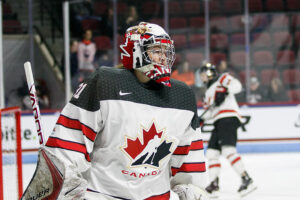 By decade’s end, she had added an Olympic gold medal from Sochi and silver at Pyeongchang (where she snuffed 44 Team USA shots in a 2-1 preliminary-round win) plus five IIHF World Championship medals. Between and beyond, she answered nods for CWHL and PWHPA teams in Boston, Calgary, and Montreal and spent two years imparting her expertise as a goalie coach for her birth city’s McGill University.
By decade’s end, she had added an Olympic gold medal from Sochi and silver at Pyeongchang (where she snuffed 44 Team USA shots in a 2-1 preliminary-round win) plus five IIHF World Championship medals. Between and beyond, she answered nods for CWHL and PWHPA teams in Boston, Calgary, and Montreal and spent two years imparting her expertise as a goalie coach for her birth city’s McGill University.
“She loved to play,” said Deraney, to whom Lacasse gifted the mask after its last shift. “Not only did she work hard, but she loved to come to the rink every day and I think that’s the sign of an elite athlete and the consummate student-athlete.
“It was never work, it was always fun, and I think because it was always fun it gave her an opportunity to be great.”
And with it, an output almost as rare as the State House dome itself.
By Al Daniel


